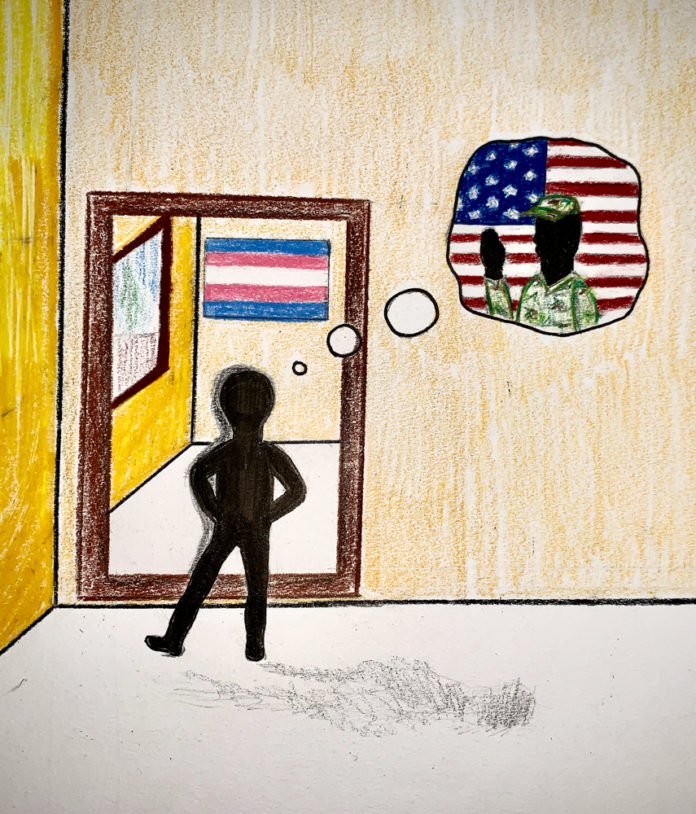The Pentagon’s controversial policy banning transgender recruits from joining the military went into effect April 12. Directly opposing the beliefs of 70 percent of American voters, this ban reversed the 2016 Obama administration act that allowed transgender people to serve and receive funding for their medical treatment. This is the second policy that specifically targets transgender people. In 2017, he amended Title IX to define transgender people out of existence. I disagree with Trump’s policy and believe that transgender people should be able to serve in the military. Trump’s transgender military ban is both discriminatory and illogical; gender identity does not impact the ability to serve, and the financial cost of transgender inclusion is minimal.
Trump has been working on this ban for nearly two years, first announcing his plan via a series of tweets July 26, 2017.
“After consultation with my Generals and military experts, please be advised that the United States Government will not accept or allow transgender individuals to serve in any capacity in the U.S. Military. Our military must be focused on decisive and overwhelming victory and cannot be burdened with the tremendous medical costs and disruption that transgender in the military would entail,” Trump tweeted.
Clay Pollock (junior), my friend who is a transgender man, said Trump’s laws make him feel like a second-class citizen.
“When I was younger, I did want to serve,” Pollock said. “I previously wanted to go to the Naval Academy when I was in eighth grade. I always wished I could serve my nation, I still want to help out and do my part. But him putting down a ban saying we are a distraction and cause more problems [shows that] he doesn’t think of us as a part of this country. We’re not the Americans he wants, the cisgender heterosexual white male ‘Make America Great Again’ Americans. He’s not here for me. He’s not my president.”
Laws promoting discrimination in the military are nothing new. Jim Crow laws that segregated black and white servicemen weren’t repealed until 1948 when President Harry Truman issued Executive Order 9981. Military service academies didn’t admit women until 1976, and gay men and lesbian women were banned from serving in the military until 1994 when President Bill Clinton issued Don’t Ask, Don’t Tell. This law stated that lesbian, gay and bisexual soldiers could serve in the military as long as they remained closeted. Don’t Ask, Don’t Tell wasn’t repealed until 2010. The military justified these rules by saying that diversifying the army would be distracting, costly and limit group cohesion. Military laws excluding people of color, women and gay people are discriminatory, and Trump’s transgender military ban isn’t any different.
According to Pollock, limited transgender visibility and the conflation of sex assigned at birth and gender has made it easier for Trump’s anti-transgender policies to persist.
“We’re only talked about if we’re famous or we’re dead,” Pollock said. “A lot of people don’t realize that sex and gender are different things in general. They don’t understand the difference between these concepts and the words to use for them. You grow up hearing, ‘You’re a female, you have these body parts, you’re a girl.’ That’s how you’re raised, and it’s very hard to break out of that.”
Trump justified the ban by stating that the military “cannot be burdened with the tremendous medical cost” of supplying the treatment for transgender soldiers. However, the cost of treatment for transgender soldiers is marginal. In a 2017 article published in the Journal of the American Medical Association, researchers estimated that nearly 13,000 transgender individuals are currently serving, 200 of whom will seek gender dysphoria-related treatment each year. This would cost between $2.4 million and $8.4 million annually, increasing the $6 billion dollar budget for active duty military members by 0.04 to 0.1 percent. That’s a negligible cost to ensure equal opportunity in the military.
The number of people enlisting in the military is declining, so limiting the number of people who can enlist weakens the United States military. In fact, in 2018 the military fell short 6,500 troops of its recruiting goal, even after spending an extra $200 million on bonuses and lowering standards to let in more recruits with conduct or health issues. In 2016, when Obama lifted the ban, the Department of Defense argued that the United States “must have access to 100 percent of America’s population for its all-volunteer force to be able to recruit from among the most highly qualified, and to retain them.”
According to Pollock, anyone who has the physical ability to serve in the military should be able to serve.
“If [a transgender person] has the credentials, and they’ve proven that they’re good soldiers and can follow orders, then they have what it takes to be in the army,” Pollock said.
Instead of banning transgender people, Pollock suggests that we educate bigots.
“The only reason [having transgender soldiers] would be a distraction, or disruptive is because of how cis people choose to perceive them,” Pollock said. “Teach men not to objectify trans people. I think it’s just about understanding our experience and our intentions. We’re not here maliciously. We’re all working for the same goal.”
Margot Heron is a sophomore Critical Theory & Social Justice and Spanish double major. She can be reached at mheron@oxy.edu.
![]()



































